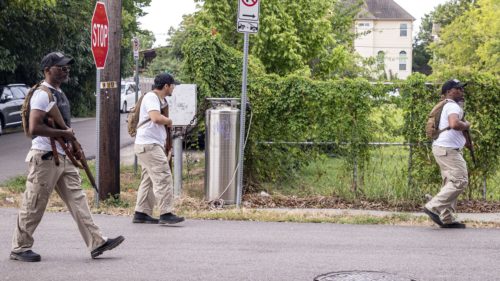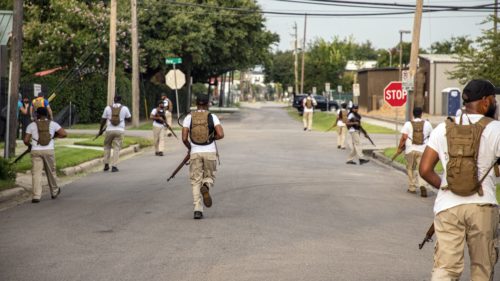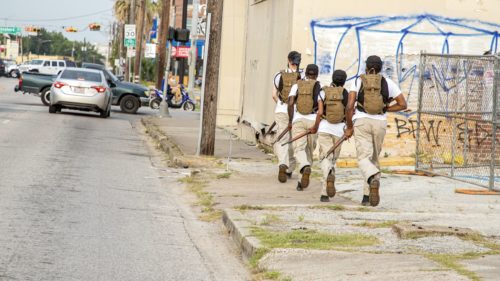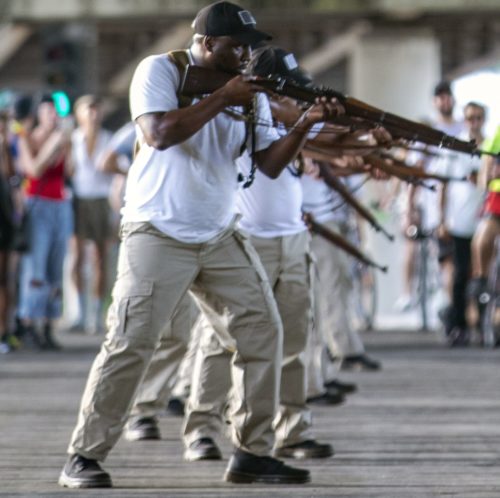Closing the Loop: Jefferson Pinder’s Fire and Movement

Jefferson Pinder, Fire and Movement, July 11, 2019, Houston, TX. (L – R: Jefferson Pinder, Manuel Breton-Santin, Harrison Guy) Photo: dabfoto creative services / david a. brown
I first met Ashley DeHoyos, Assistant Curator for DiverseWorks, Jefferson Pinder, the director of Fire and Movement, and Joseph Lefthand, who led drill instruction for the performers, on a balmy summer day in midtown Houston at a coffee house that was once a gas station. It seemed the perfect location to discuss with the Fire and Movement team the notion of hidden history, particularly that of Houston’s history, which is largely hidden in plain sight. DeHoyos spoke to me at length about her participation in the Freddie Gray protests, and realizing that she knew more about Baltimore’s history, than that of Houston, her hometown. That’s when Pinder made clear that he wanted to capture this idea of incidents that for years haven’t been made accessible. “People weren’t talking about it because there was a systematic cover up,” Pinder said. Further, Pinder wanted to connect the past with the present, how little of these hidden politically-engaged histories are being contextualized with the racial and political issues we’re facing in the current climate.
Fire and Movement is inspired by the 1917 Camp Logan Uprising, also referred to as “the Houston Riot,” or “Camp Logan Mutiny.” The uprising saw highly trained African American soldiers of the 3rd Battalion of the 24th United States Infantry revolt after a Black military officer, Private Alonzo Edwards, was arrested and beaten when he tried to intervene with the arrest of a local washerwoman by two Houston police officers in the Fourth Ward. Historians would later describe this night as one of Houston’s ugliest moments, with newspapers reporting the deaths of seventeen individuals, including policemen and soldiers.

Jefferson Pinder, Fire and Movement, July 11, 2019, Houston, TX. Photo: dabfoto creative services / david a. brown
The fourteen Black and Brown performers, dressed in costumes designed by Pinder that consisted of hydration packs, Dr Marten boots, tactical pants, white t-shirts, authentic M 1903 Springfield rifles, and baseball caps emblazoned with upside down American flags (which symbolized the wearer being under siege or indicated a sign of distress), physically reenacted the journey that the original soldiers took on the night of the uprising.
The project consisted of four phases: Phase 1 began at the intersection of Center and Moy Streets. During Phase 2 the performers performed a short movement demonstration at the Shepherd Street Footbridge at Buffalo Bayou Park. Phase 3 provided a somber moment to memorialize the lives that were lost, at College Memorial Park Cemetery, and the final phase, Phase 4, closed the night with an extended performance at the African American Library at the Gregory School.
I had the unique opportunity to consume this performance in various modes throughout the rehearsal and live performance. Two days before the performance was open to the public, I walked the entire route with DeHoyos and a group of volunteers. It was a hot, grueling experience to walk the journey behind the performers, and it gave me an appreciation not only for the physical and emotional terrain of the performers themselves—it was physically taxing and uncomfortable in Houston’s summer heat, and I was not being asked to perform in unison while carrying a weighted rifle—but also for what the original soldiers experienced in the initial uprising a hundred years earlier.

Jefferson Pinder, Fire and Movement, July 11, 2019, Houston, TX. Photo: dabfoto creative services / david a. brown
On the day of the performance, I was able to witness the performance in two different modes. I began my experience of the performance by driving my car to the meeting place of Phase 1. I had naively assumed that I could drive next to the performers as they walked to the different phases of the project. However, it was impossible to do this without slowing down traffic or obstructing the performers from their journey. As I drove up to the starting point, the Houston police on hand waved me away. I found it difficult to figure out exactly from what location I needed to drive to park so that I could properly watch the footbridge performance. It was incredibly stressful to look for the location while also trying to manage the busyness of the traffic on Houston’s roads on a Thursday night, and so I barely missed the footbridge performance. Luckily, I found the cemetery by car just in time to watch the performance that took place at the cemetery. Finally, I made my way to the Gregory School and was able to catch the performers en route to their final performance on the live feed that had been set up in a small room.
There was something very Houston to me about witnessing and imagining this crucial piece of Houston’s hidden history through all the idiosyncratic ways that one can witness other lives within this sprawling indefinable place. The most unusual experience I had of this city to witness this project coming into being was most certainly that of being on foot, in the heat of summer, in a city mostly not designed, at least in today’s version, to be traversed by foot. To attempt to find these bodies by car while navigating the traffic that is a result of such an incredibly fast growing city felt very Houston to me, frustratingly authentic. To close out the night in a highly air-conditioned building that once served as the first public school for African Americans in Houston, located in Houston’s Fourth Ward, the city’s oldest established African American community, felt the perfect close to a performance indelibly wedded to the story of Black life in the city of Houston.

Jefferson Pinder, Fire and Movement, July 11, 2019, Houston, TX. (Pictured: Brian Ellison) Photo: dabfoto creative services / david a. brown
In terms of the performances themselves, Phases 1 and 2 combined military movement with reenactments of actual positions of aiming their rifles that were taken in order to protect themselves (or be ready to defend themselves from other armed individuals). Phase 3, which took place at the cemetery where many of the casualties are still buried, was a somber moment. The audience, standing on the grounds of the cemetery, watched a group of performers line in patrol formation and take laps around the cemetery while other performers stood in front of graves silently. At one point, one performer sang an incredibly powerful rendition of the Gospel hymn, “Lord, I’m Coming Home.” The final phase of the performance, which took place at the Gregory School, rounded out the evening while depicting the performers marching, falling, and reciting text from a song, the actual court case for the uprising, an Angela Davis speech, and a play by Amiri Baraka.
When I spoke with Joseph Lefthand during the rehearsal phase of the project, he described this project as “closing the loop.” Having been part of the U.S. Marine Corps and having experience with his body being weaponized in both his training and also fighting in Afghanistan and Iraq, Lefthand stated that he wanted to take the “embodied knowledge he learned as his body was being trained as a tool of violence and to now take that agency and learn how we want to use our body now. What does it mean to train citizens, civilians, in weapons and tactics without the authority of the government? What right do we have to do that?” For me, the performance at the Gregory School was another kind of closing of the loop, as we got a true sense of these participants in the uprising as individuals, as they recited text that evoked the experience they lived through as Black men, but also as members of an oppressed and segregated city as soldiers. As Pinder states, “We like to think that things have changed. If we repurpose and reenact and reclaim history, we’ll see what hasn’t changed. If we tug at the history from back then, I think we’ll notice that the same sentiments will arise.”
In closing, Fire and Movement was a timely and powerful reenactment of the 1917 Camp Logan uprising, engaging with how the past racial tensions of Houston are still connected to our current conversation of weaponization, militarization, segregation, racism, and police brutality. Pinder and Lefthand’s directing and staging of political and military site-specific choreography that moved through the terrain of the original uprising provided a small window into a part of Houston’s history that was not only hidden, but forced underground. It is my hope that this performance helped bring awareness to Houston’s past of civic disobedience in order to decide how we continue to navigate similar issues, even a hundred years later.



incredible sight